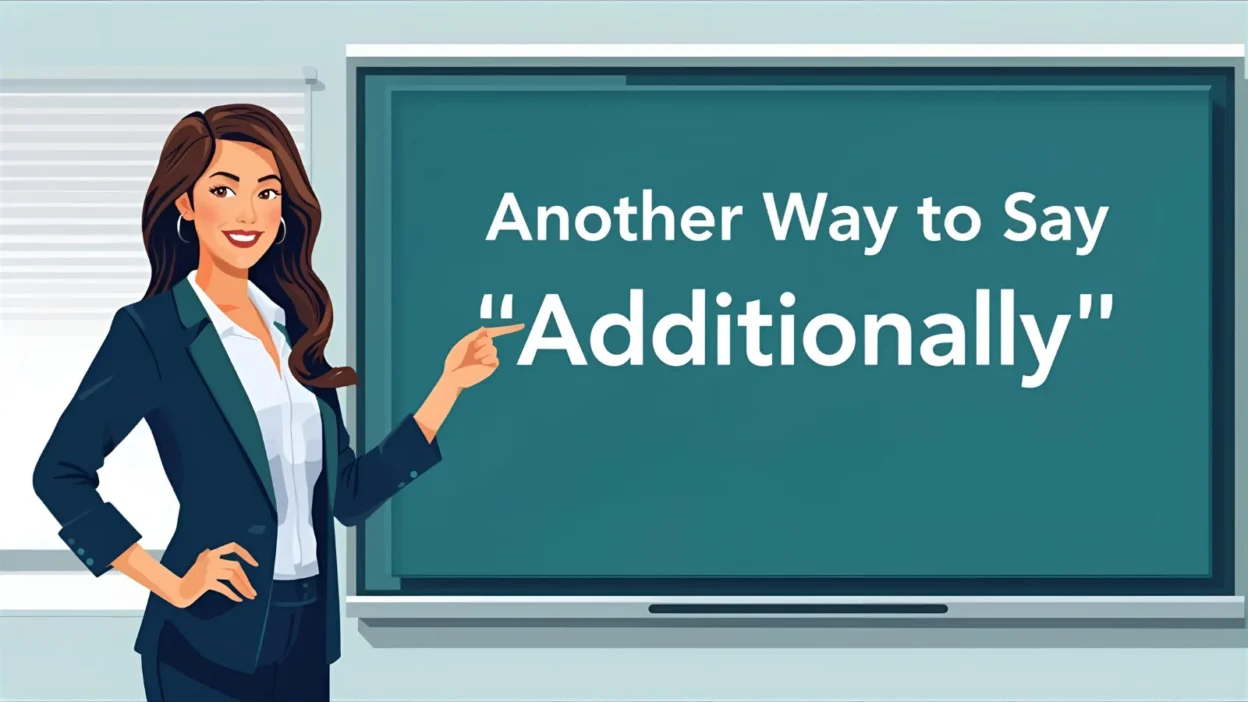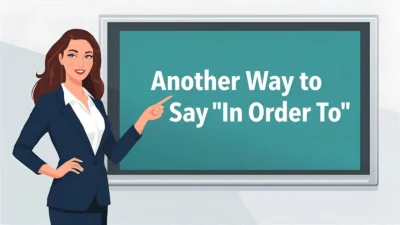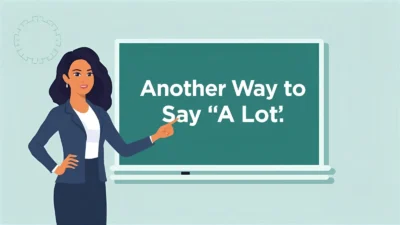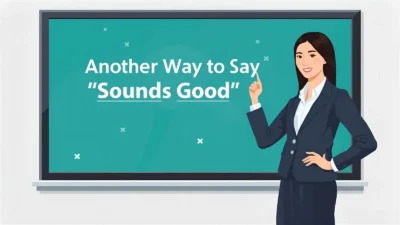The word “additionally” is a helpful connector in English, often used to introduce extra information, strengthen an argument, or expand on a point. While it works well in formal writing, repeating it too often can make your text sound stiff or monotonous. By learning synonyms and alternatives, you can express the same idea in more natural, engaging, and context-appropriate ways.
In this article, you’ll discover 35 alternatives to “additionally,” each with its meaning, detailed explanation, example sentence, best use, and tone description.
1. Moreover
Meaning: Adds weight to the previous point.
Detailed Explanation: Common in essays and reports; stronger than “additionally.”
Scenario Example: The project is cost-effective; moreover, it’s environmentally friendly.
Best Use: Academic, professional writing.
Tone: Formal, persuasive.
2. Also
Meaning: Adds extra information simply.
Detailed Explanation: Widely used in both speech and writing; very versatile.
Scenario Example: She’s a skilled pianist and also sings beautifully.
Best Use: Everyday conversation, informal writing.
Tone: Neutral, casual.
3. As well
Meaning: Highlights something extra.
Detailed Explanation: More common in speech than in formal writing.
Scenario Example: He brought his laptop and his tablet as well.
Best Use: Conversation, informal writing.
Tone: Friendly, casual.
4. In addition
Meaning: Introduces supporting information.
Detailed Explanation: Strong alternative, often used in academic or professional settings.
Scenario Example: In addition to his degree, he has five years of experience.
Best Use: Reports, essays, formal contexts.
Tone: Formal, clear.
5. What’s more
Meaning: Emphasizes something important that follows.
Detailed Explanation: Adds a persuasive or dramatic flair.
Scenario Example: She’s hardworking; what’s more, she inspires others.
Best Use: Persuasive writing, speeches.
Tone: Engaging, persuasive.
6. As well as that
Meaning: Adds another piece of information.
Detailed Explanation: More natural in spoken English.
Scenario Example: He’s an excellent teacher; as well as that, he’s a kind mentor.
Best Use: Conversations, informal writing.
Tone: Casual, friendly.
7. Along with
Meaning: Combines multiple items or ideas.
Detailed Explanation: Suggests things happening together.
Scenario Example: She came along with her best friend.
Best Use: Speech, narratives.
Tone: Casual, descriptive.
8. Coupled with
Meaning: Shows connection of two things.
Detailed Explanation: Works well when combining cause and effect.
Scenario Example: His determination, coupled with his skills, led to success.
Best Use: Professional, academic, persuasive writing.
Tone: Formal, logical.
9. Plus
Meaning: Simple way of adding.
Detailed Explanation: Very informal, often used in conversation.
Scenario Example: It’s cheap, plus it looks good.
Best Use: Informal speech, casual writing.
Tone: Relaxed, conversational.
10. On top of that
Meaning: Adds emphasis to an extra point.
Detailed Explanation: Slightly informal; emphasizes piling on benefits or problems.
Scenario Example: The rent is too high; on top of that, the apartment is small.
Best Use: Speech, casual writing.
Tone: Informal, emphatic.
11. Together with
Meaning: Combines things in addition.
Detailed Explanation: Neutral and flexible; works in different contexts.
Scenario Example: Together with his team, he solved the issue.
Best Use: General use—formal and informal.
Tone: Neutral, cooperative.
12. As an added bonus
Meaning: Highlights extra benefits.
Detailed Explanation: Casual but persuasive; emphasizes a positive point.
Scenario Example: The phone is affordable; as an added bonus, it comes with free earbuds.
Best Use: Marketing, casual writing.
Tone: Positive, promotional.
13. In like manner
Meaning: Adds similar information.
Detailed Explanation: Slightly formal; connects comparable ideas.
Scenario Example: She is diligent. In like manner, her brother is hardworking.
Best Use: Formal essays, structured writing.
Tone: Formal, academic.
14. As well as
Meaning: Introduces extra items smoothly.
Detailed Explanation: Natural and flexible phrase.
Scenario Example: She speaks English as well as French.
Best Use: Academic, professional, everyday use.
Tone: Neutral, versatile.
15. Not only that
Meaning: Builds excitement for extra information.
Detailed Explanation: Often used in persuasive contexts.
Scenario Example: The service is reliable. Not only that, it’s affordable.
Best Use: Marketing, persuasive writing, speeches.
Tone: Persuasive, engaging.
16. Over and above that
Meaning: Stresses something extra or beyond.
Detailed Explanation: Slightly formal but still conversational.
Scenario Example: Over and above that, he volunteered in the community.
Best Use: Semi-formal writing, speeches.
Tone: Emphatic, formal.
17. Likewise
Meaning: Shows similarity and addition.
Detailed Explanation: Often used in formal or polite contexts.
Scenario Example: She enjoyed the book. Likewise, her friends praised it.
Best Use: Essays, professional communication.
Tone: Formal, respectful.
18. Similarly
Meaning: Adds a parallel idea.
Detailed Explanation: Good for comparisons or extending arguments.
Scenario Example: The first method worked well. Similarly, the second proved effective.
Best Use: Academic writing, reports.
Tone: Formal, logical.
19. To boot
Meaning: Informal way to say “as well.”
Detailed Explanation: Old-fashioned but still appears in casual writing.
Scenario Example: He’s smart, funny, and handsome to boot.
Best Use: Informal writing, storytelling.
Tone: Casual, humorous.
20. Over and beyond
Meaning: Adds emphasis on extra effort or quantity.
Detailed Explanation: Suggests something more than expected.
Scenario Example: She went over and beyond her responsibilities.
Best Use: Praise, professional contexts.
Tone: Positive, emphatic.
21. What is more
Meaning: Adds something important.
Detailed Explanation: Similar to “what’s more,” slightly more formal.
Scenario Example: The plan is affordable. What is more, it’s effective.
Best Use: Persuasive writing, formal arguments.
Tone: Semi-formal, persuasive.
22. Into the bargain
Meaning: Extra benefit or surprise.
Detailed Explanation: Slightly old-fashioned but engaging.
Scenario Example: She’s talented and kind into the bargain.
Best Use: Storytelling, informal writing.
Tone: Quirky, casual.
23. Equally
Meaning: Adds balance to two points.
Detailed Explanation: Useful when stressing fairness or similarity.
Scenario Example: Equally important is the need for transparency.
Best Use: Academic, professional.
Tone: Formal, balanced.
24. Further
Meaning: Introduces an additional idea.
Detailed Explanation: Concise and professional alternative.
Scenario Example: Further, studies show consistent results.
Best Use: Academic, professional reports.
Tone: Formal, concise.
25. In conjunction with
Meaning: Shows things combined or working together.
Detailed Explanation: Common in technical or formal writing.
Scenario Example: This medicine works best in conjunction with a healthy diet.
Best Use: Medical, technical, academic contexts.
Tone: Formal, precise.
Conclusion
While “additionally” is a clear and useful transition, relying on it too often may reduce the variety in your communication. By choosing alternatives like “moreover” for academic writing, “also” for everyday conversation, or “on top of that” for casual speech, you can better adapt your tone to fit the context. These 35 alternatives give you the tools to keep your writing and speech engaging, dynamic, and polished.



